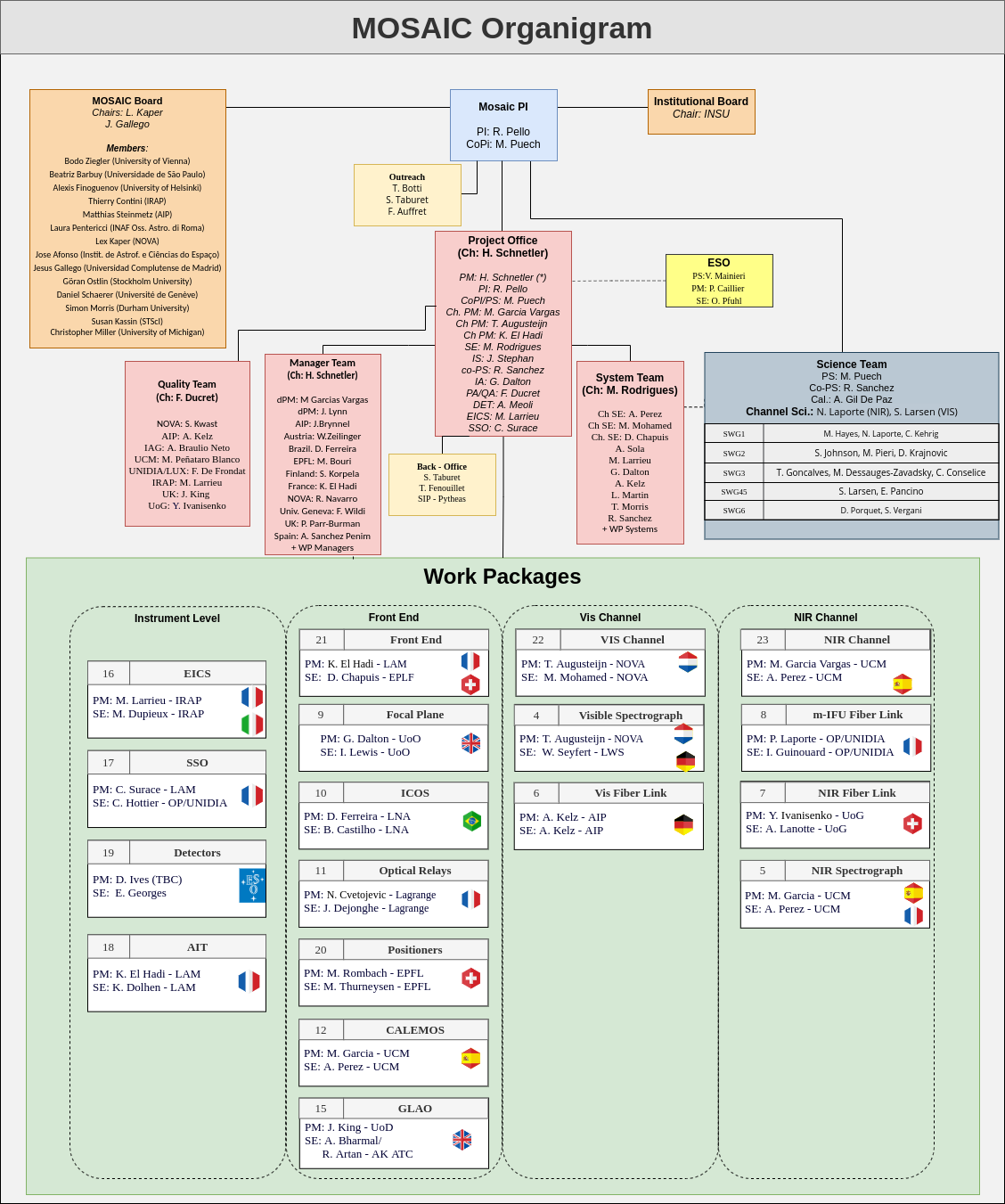 A broad range of science cases for multi-object spectroscopy on the ELT demand better angular resolution than typically obtained from astronomical seeing, requiring the use of adaptive optics (AO) over fields of view of several arcminutes on the sky. A broad range of science cases for multi-object spectroscopy on the ELT demand better angular resolution than typically obtained from astronomical seeing, requiring the use of adaptive optics (AO) over fields of view of several arcminutes on the sky. | ||
| The James Webb Space Telescope (JWST), with its high spatial resolution and superb imaging sensitivity in the near-infrared (NIR), will soon become the prime observatory for the discovery and investigation of high redshift galaxies. In addition, the southern sky will be simultaneously targeted by ESA’s Euclid mission and the Large Synoptic Survey Telescope (LSST), providing detailed galaxy observations up to intermediate redshifts. As such, multiple synergies arise with MOSAIC. | ||
 The combination of structural and morphological properties derived from JWST/NIRCam deep imaging and the highly multiplexed, spatially-resolved spectroscopic capabilities offered by MOSAIC will produce the first systematic census of the mass assembly and star formation histories of galaxies out to z ~ 4. This will allow us to infer their dynamical state, to study the properties of their stellar populations and the interstellar medium, to unveil their chemical enrichment histories, and to quantify the evolution of fundamental scaling relations involving galaxy masses, sizes, and kinematics.
The combination of structural and morphological properties derived from JWST/NIRCam deep imaging and the highly multiplexed, spatially-resolved spectroscopic capabilities offered by MOSAIC will produce the first systematic census of the mass assembly and star formation histories of galaxies out to z ~ 4. This will allow us to infer their dynamical state, to study the properties of their stellar populations and the interstellar medium, to unveil their chemical enrichment histories, and to quantify the evolution of fundamental scaling relations involving galaxy masses, sizes, and kinematics.  MOSAIC will efficiently carry out spectroscopic follow-up studies of new targets identified through JWST imaging. For example, over the redshift range 5 < z < 9 it is expected that JWST will obtain high quality near-to-mid IR photometry for over a thousand sources within the patrol field of MOSAIC. And while JWST/NIRSpec can provide low-resolution observations of the brightest targets, the JWST will have a limited spectroscopic sensitivity compared to the ELT due to its smaller collecting area. This is a particularly severe problem for continuum and absorption-line spectroscopic studies, which can only be efficiently carried out for samples this large with a wide-field, highly-multiplexed, and extremely sensitive instrument like MOSAIC.
MOSAIC will efficiently carry out spectroscopic follow-up studies of new targets identified through JWST imaging. For example, over the redshift range 5 < z < 9 it is expected that JWST will obtain high quality near-to-mid IR photometry for over a thousand sources within the patrol field of MOSAIC. And while JWST/NIRSpec can provide low-resolution observations of the brightest targets, the JWST will have a limited spectroscopic sensitivity compared to the ELT due to its smaller collecting area. This is a particularly severe problem for continuum and absorption-line spectroscopic studies, which can only be efficiently carried out for samples this large with a wide-field, highly-multiplexed, and extremely sensitive instrument like MOSAIC.
At even higher redshifts MOSAIC will establish the Ly-α properties of 7 < z < 15 sources discovered by JWST. With these measurements it will be possible to accurately determine the hydrogen ionisation fraction in the intergalactic medium and its evolution with redshift, effectively measuring the cosmic reionisation history and determining important properties of the first galaxies in the Universe, from gas outflows to characterising the interstellar medium and the stellar population contents.
In summary, we envision the combination of JWST and MOSAIC as the ultimate tool for studies of high redshift galaxies and of the history of cosmic reionisation.
To map the intergalactic medium at 3 < z < 4, MOSAIC will need to target thousands of V < 25.5 mag galaxies in this redshift range in an area of ~ 1 square degree in the sky. Prior information about the galaxies in that part of the sky, in particular their redshifts, is needed in order to plan the survey. Combined optical and near-infrared imaging of the Euclid and LSST surveys will provide galaxy redshifts in a large (>= 7000 degree^2) area of the southern sky with the required accuracy. Furthermore, adding the infrared JWST observations to the Euclid and LSST data will result in a detailed knowledge of galaxy characteristics (such as star formation rate and stellar mass), and allow to study how the intergalactic medium affects galaxy evolution at 3 < z < 4.
The project development plan breaks down into the following major phases with some sub-phases:
- Phase B is aimed at flowing all specification down to modules and achieve a preliminary design maturity. This phase is separated into two:
- Phase B1: More concentrated in the flow down of requirement and architecture definition to sub- system level
- Phase B2: Preliminary design activities.
- Phase C is aimed at achieving the final design of the instrument up to component. It ends with the final design reviews to free the Manufacturing drawings definition.
- Phase D will cover the manufacturing, system AIV/T and instrument AIT/V. This phase will end with the Preliminary Acceptance in Europe.
- Phase E will cover the activities of packing, shipping and preliminary acceptance in Chile.
|
| ||




